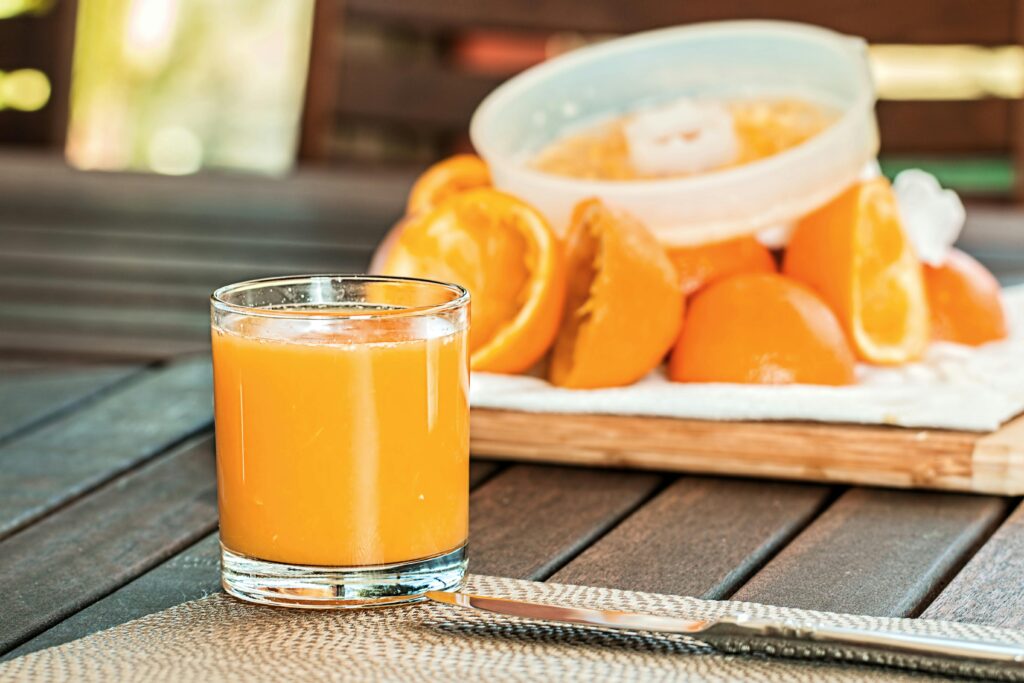Freshly squeezed orange juice is one of the simplest yet most refreshing drinks you can make at home. Unlike store-bought juice, homemade orange juice is free from preservatives, added sugar, and artificial flavors. It’s packed with vitamin C, antioxidants, and natural sweetness, making it a perfect drink to start your day.
If you’ve ever wondered how to make orange juice step by step, this guide covers everything you need to know – from choosing the right oranges to different juicing methods and storage tips.
Why Choose Homemade Orange Juice?
Before jumping into the process, let’s quickly understand why homemade juice is better:
- No Added Sugar: Store-bought juices often contain hidden sugars and syrups.
- More Nutrients: Fresh juice retains more vitamins and enzymes.
- Customizable: You can adjust pulp levels, add a hint of lemon, or mix with other fruits.

- Cost-Effective: Buying oranges and juicing them is often cheaper than premium bottled juices.
What You Need to Make Orange Juice
Making orange juice at home doesn’t require a lot of fancy equipment. Depending on your budget and convenience, you can use different tools:
Ingredients:
- Fresh oranges (navel, Valencia, or blood oranges are best)
- Ice cubes (optional)
- Honey or sugar (optional, but usually not needed)
Equipment:
- Hand juicer / citrus press
- Electric juicer (optional, for convenience)
- Blender (alternative method)
- Strainer (to remove seeds and pulp if desired)
Step-by-Step: How to Make Orange Juice
Step 1: Choose the Best Oranges
The flavor of your juice depends largely on the oranges you pick. Here are some popular varieties:
- Navel Oranges – Sweet, seedless, and perfect for juicing.
- Valencia Oranges – Juicy and tangy, available in summer.
- Blood Oranges – Unique reddish color with a berry-like flavor.
👉 Tip: Choose oranges that feel heavy for their size. This means they are juicy.
Step 2: Wash and Prepare
Wash the oranges thoroughly to remove dirt or chemicals from the peel.
- Roll the orange gently on a flat surface with your palm – this helps release more juice.
- Slice each orange into halves.
Step 3: Juice the Oranges
Now it’s time to extract the juice. You can choose from different methods:
Method 1: Using a Hand Juicer
- Place the orange half on the juicer.
- Press and twist until the juice flows out.
- Collect it in a glass or jug.
Method 2: Using with an Electric Juicer
- Place the orange halves in the juicer.
- Turn it on and let the machine extract the juice quickly.
- This method is faster and ideal if you juice regularly.
Method 3: Using a Blender
- Peel the oranges and remove seeds.
- Cut into small pieces and blend until smooth.
- Strain the mixture using a fine sieve or cheesecloth if you prefer pulp-free juice.
Step 4: Strain (Optional)
If you don’t like pulp, pour the juice through a strainer. For extra smooth juice, use a muslin cloth.
Step 5: Serve Fresh
Pour the juice into a glass, add ice cubes if you like it chilled, and enjoy immediately. Fresh orange juice tastes best when consumed within 15–20 minutes of preparation.
Variations of Orange Juice Recipes
Once you know the basics, you can get creative with your orange juice:
- Orange-Lemon Juice: Add a squeeze of lemon for extra tanginess.
- Orange-Carrot Juice: Blend oranges with carrots for a vitamin-rich drink.
- Orange-Ginger Juice: A dash of ginger adds warmth and boosts immunity.
- Orange-Smoothie: Blend with banana and yogurt for a creamy breakfast smoothie.
Health Benefits of Orange Juice
Fresh orange juice is not only delicious but also full of health benefits:
- Boosts Immunity: Rich in vitamin C.
- Improves Digestion: Natural fiber helps regulate digestion.
- Supports Heart Health: Contains potassium and antioxidants.
- Hydration: Keeps you refreshed and hydrated.
Storage Tips
Fresh juice is always best, but if you need to store it:
- Keep it in an airtight glass jar.
- Refrigerate immediately.
- Consume within 24–48 hours for maximum freshness.
- Shake before drinking, as natural juice may separate.
Common Mistakes to Avoid
- Using underripe or overripe oranges (they can taste sour or bitter).
- Adding too much sugar (fresh juice doesn’t need it).
- Storing juice for too long (nutrients degrade quickly).
FAQs About Making Orange Juice
- Can I make orange juice without a juicer?
Yes! You can use a blender or even squeeze oranges by hand. Just strain afterward for a smoother texture.
- Do I need to add sugar to orange juice?
No, fresh oranges are naturally sweet. If you like extra sweetness, add a little honey instead of sugar.
- Which oranges are best for juicing?
Valencia and navel oranges are the most popular because of their sweetness and high juice content.
- Can I freeze orange juice?
Yes, but freezing may slightly change the taste and texture. Store in ice cube trays for convenience.
- How much juice can I get from one orange?
On average, one medium orange yields about 1/3 cup of juice.
Final Thoughts
Learning how to make orange juice at home is simple, affordable, and incredibly rewarding. With just a few oranges and basic tools, you can enjoy fresh, vitamin-packed juice anytime. Whether you like it pulpy, smooth, or mixed with other fruits, homemade orange juice is always a healthier choice than store-bought alternatives.
So, grab some oranges today and start squeezing your way to a refreshing and healthy lifestyle!
Read another interesting blogs here about :
How to Clean a Juicer | Simple Tips for a Fresh and Healthy Appliance
Read more:


Wow